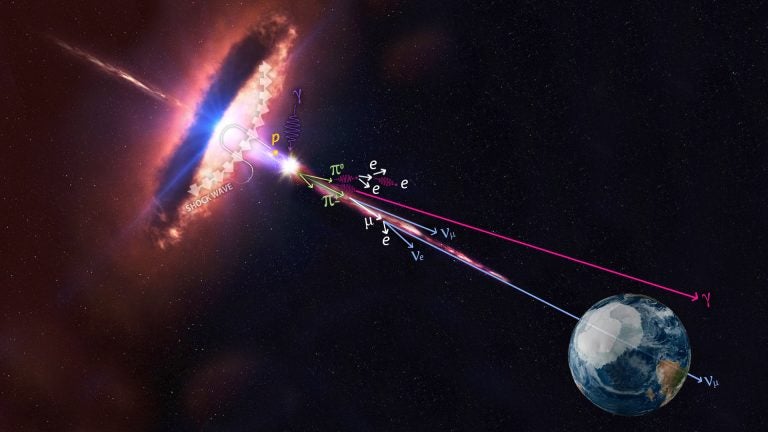Astronomers identify supermassive black hole as source of neutrinos
A team of astronomers believe they've found the mysterious source of high energy neutrinos that travel for billions of light years in space before hitting Earth.

In this artistic rendering, a blazar is accelerating protons that produce pions, which produce neutrinos and gamma rays. Neutrinos are always the result of a hadronic reaction such as the one displayed here. Gamma rays can be produced in both hadronic and electromagnetic interactions. (Artist rendering courtesy IceCube/NASA)
For more than a century, scientists have searched for the source of neutrinos that fly through space at nearly the speed of light. These tiny, nearly massless particles are created from violent astrophysical events like exploding stars and gamma ray bursts.
And now, scientists at a South Pole observatory have traced neutrinos to their source for the first time.
The University of Maryland’s Regina Caputo says the source of these tiny particles has been identified as a galaxy about four billion light years from Earth. “This particular galaxy has a very dense core at the center, and at that core is a supermassive black hole that’s millions to billions the times of the mass of the sun … now sometimes these particular galaxies shoot out jets of particles. These blazar jets are true cosmic accelerators.”

University of Delaware astronomy professor Thomas Gaisser is also part of the research team, he calls the discovery the “smoking gun” identifying this galaxy as a source of high-energy cosmic rays and neutrinos. “Active galaxies have always been the leading contender for producing high-energy cosmic rays and neutrinos, but we didn’t have the evidence until now,” Gaisser said.
The mystery has puzzled astronomers for more than a hundred years. “When you get to mysteries of the cosmos on a grand scale that’s really magic,” said National Science Foundation Director France Córdova. “Going after those mysteries — whether it’s dark matter or dark energy, the origin of cosmic rays — is what really science is all about, is uncovering the mysteries of nature.”
Córdova says the results, which are being published in the journal “Science” on July 13, raise new questions and will open new doors for research. “As in all good science, this is only the beginning, and that’s exciting.”
WHYY is your source for fact-based, in-depth journalism and information. As a nonprofit organization, we rely on financial support from readers like you. Please give today.





